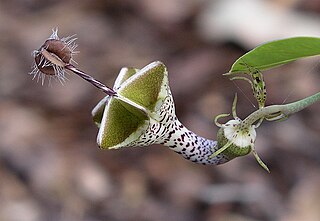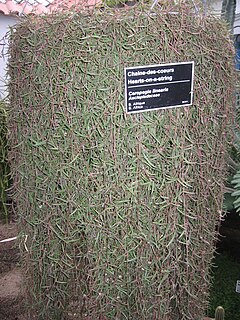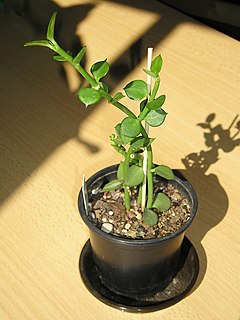
Ceropegia is a genus of plants within the family Apocynaceae, native to Africa, southern Asia, and Australia. It was named by Carl Linnaeus, who first described this genus in his Genera plantarum, which appeared in 1737. Linnaeus referred to the description and picture of a plant in the Horti Malabarici as the plant for which the genus was created. In 1753 he named this species as Ceropegia candelabrum. Linnaeus did not explain the etymology but later explanations stated that the name Ceropegia was from the Greek word keropegion κηροπηγɩον. This means candelabrum in Latin, which has a broader range than the modern word - "a candlestick, a branched candlestick, a chandelier, candelabrum, or also lamp-stand, light-stand, sometimes of exquisite workmanship".

Murlen National Park is a national park located in the Champhai district Mizoram in India. The size of the park area is 200 km2 (77 sq mi). The park is situated about 245 km east of Aizawl, and is close to the Chin Hills. It lies north of Lengteng Wildlife Sanctuary in the same district. It covers an area of approximately 100 km2. The tropical, semi-evergreen and sub montane Forests of Murlen are home to a rich variety of flora and fauna. About 15 species of mammals, 150 species of birds, 35 species of Medicinal plants, 2 species of bamboos, and 4 species of orchids so far have been recorded in this Park. At present, 36 people are involved in conservation work of Murlen National Park.

Ceropegia woodii is a flowering plant in the dogbane family Apocynaceae, native to South Africa, Eswatini and Zimbabwe. It is sometimes treated as a subspecies of the related Ceropegia linearis, as C. linearis subsp. woodii. Common names include chain of hearts, collar of hearts, string of hearts, rosary vine, hearts-on-a-string, and sweetheart vine.

Ulmus castaneifoliaHemsley, the chestnut-leafed elm or multinerved elm, is a small deciduous tree found across much of China in broadleaved forests at elevations of 500–1,600 metres (1,600–5,200 ft).

Ulmus szechuanicaFang, known as the Szechuan (Sichuan), or red-fruited, elm, is a small to medium deciduous Chinese tree found along the Yangtze river through the provinces of Sichuan, Jiangxi, Anhui, and Jiangsu.

A species that is extinct in the wild (EW) is one that has been categorized by the International Union for Conservation of Nature as known only by living members kept in captivity or as a naturalized population outside its historic range due to massive habitat loss.

Trachycarpus nana is a species of flowering plant in the family Arecaceae. It is found only in China. Its natural habitat is subtropical or tropical moist lowland forests. It is threatened by habitat loss.
Ceropegia decidua is a species of plant in the family Apocynaceae. It is found in South Africa and Swaziland.
Ceropegia dinteri is a species of plant in the family Apocynaceae. It is endemic to Namibia. Its natural habitats are subtropical or tropical dry shrubland and rocky areas.

Helicia is a genus of 110 species of trees and shrubs, constituting part of the plant family Proteaceae. They grow naturally in rainforests throughout tropical South and Southeast Asia, including India, Sri Lanka, Indochina, Peninsular Malaysia to New Guinea and as far south as New South Wales.
Staurogyne sichuanica is a species of plant in the family Acanthaceae. It is endemic to China.

Ceropegia sandersonii is a species of flowering plant in the family Apocynaceae that is native to Mozambique, South Africa, and Swaziland. Common names are parachute plant, fountain flower, and umbrella plant.

Ceropegia elegans is a plant species that belongs to the genus Ceropegia. It is endemic to India and Sri Lanka.

Ceropegia linearis is a species of flowering plant in the family Apocynaceae, native to Southern Africa.

Ceropegia candelabrum is the type species in its genus of plants, belonging the subfamily Asclepiadoideae. The specific epithet is derived from the candelabra-like appearance of the inflorescences.
Ceropegia huberi is a species of plant.
Ceropegia anjanerica is a species of flowering plant in the family Apocynaceae. Flowers are 2.5-3.5 cm long, usually slightly curved and greenish yellow in color and the plants are up to 20cm high. It is endemic to the Anjaneri Hills area of Nashik district.

Ceropegia radicans is a species of herb in the family Apocynaceae. The leaves are fleshy and glabrous and it has a large cage-like flower with a slender tube swollen at the base, and divided into five segments at the top. It grows up to 20cm in height.

Ceropegia rhynchantha is a species of plants in the family Apocynaceae. It occurs in West Africa and has slender flowers, with basal inflation and slight expansion of the tube towards the mouth, as well as relatively long, narrow lobes.














